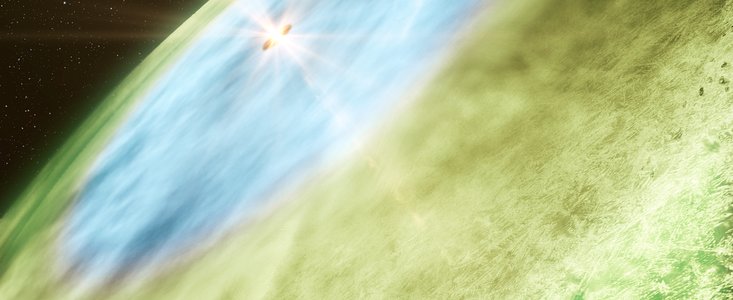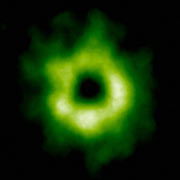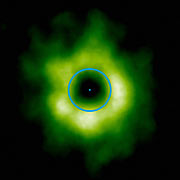Press Release
Snow in an Infant Planetary System
A frosty landmark for planet and comet formation
18 July 2013
A snow line has been imaged in a far-off infant planetary system for the very first time. The snow line, located in the disc around the Sun-like star TW Hydrae, promises to tell us more about the formation of planets and comets, the factors that decide their composition, and the history of the Solar System. The results are published today in Science Express.
Astronomers using the Atacama Large Millimeter/submillimeter Array (ALMA) have taken the first ever image of the snow line in an infant planetary system. On Earth, snow lines form at high altitudes where falling temperatures turn the moisture in the air into snow. This line is clearly visible on a mountain, where the snow-capped summit ends and the rocky face begins.
The snow lines around young stars form in a similar way, in the distant, colder reaches of the dusty discs from which planetary systems form. Starting from the star and moving outwards, water (H2O) is the first to freeze, forming the first snow line. Further out from the star, as temperatures drop, more exotic molecules can freeze and turn to snow, such as carbon dioxide (CO2), methane (CH4), and carbon monoxide (CO). These different snows give the dust grains a sticky outer coating and play an essential role in helping the grains to overcome their usual tendency to break up in collisions, allowing them to become the crucial building blocks of planets and comets. The snow also increases how much solid matter is available and may dramatically speed up the planetary formation process.
Each of these different snow lines — for water, carbon dioxide, methane and carbon monoxide — may be linked to the formation of particular kinds of planets [1]. Around a Sun-like star in a planetary system like our own, the water snow line would correspond to a distance between the orbits of Mars and Jupiter, and the carbon monoxide snow line would correspond to the orbit of Neptune.
The snow line spotted by ALMA is the first glimpse of the carbon monoxide snow line, around TW Hydrae, a young star 175 light-years away from Earth. Astronomers believe this budding planetary system shares many of the same characteristics of the Solar System when it was just a few million years old.
“ALMA has given us the first real picture of a snow line around a young star, which is extremely exciting because of what it tells us about the very early period in the history of the Solar System,” said Chunhua “Charlie” Qi (Harvard-Smithsonian Center for Astrophysics, Cambridge, USA) one of the two lead authors of the paper. “We can now see previously hidden details about the frozen outer reaches of another planetary system similar to our own.”
But the presence of a carbon monoxide snow line could have greater consequences than just the formation of planets. Carbon monoxide ice is needed to form methanol, which is a building block of the more complex organic molecules that are essential for life. If comets ferried these molecules to newly forming Earth-like planets, these planets would then be equipped with the ingredients necessary for life.
Before now, snow lines had never been imaged directly because they always form in the relatively narrow central plane of a protoplanetary disc, so their precise location and extent could not be determined. Above and below the narrow region where snow lines exist, the star’s radiation prevents ice formation. The dust and gas concentration in the central plane is necessary to insulate the area from the radiation so that carbon monoxide and other gases can cool and freeze.
This team of astronomers succeeded in peering inside this disc to where the snow has formed with the help of a clever trick. Instead of looking for the snow — as it cannot be observed directly — they searched for a molecule known as diazenylium (N2H+), which shines brightly in the millimetre portion of the spectrum, and so is a perfect target for a telescope such as ALMA. The fragile molecule is easily destroyed in the presence of carbon monoxide gas, so would only appear in detectable amounts in regions where carbon monoxide had become snow and could no longer destroy it. In essence, the key to finding carbon monoxide snow lies in finding diazenylium.
ALMA's unique sensitivity and resolution has allowed the astronomers to trace the presence and distribution of diazenylium and find a clearly defined boundary approximately 30 astronomical units from the star (30 times the distance between the Earth and the Sun). This gives, in effect, a negative image of the carbon monoxide snow in the disc surrounding TW Hydrae, which can be used to see the carbon monoxide snow line precisely where theory predicts it should be — the inner rim of the diazenylium ring.
"For these observations we used only 26 of ALMA's eventual full complement of 66 antennas. Indications of snow lines around other stars are already showing up in other ALMA observations, and we are convinced that future observations with the full array will reveal many more of these and provide further, exciting insights into the formation and evolution of planets. Just wait and see,” concludes Michiel Hogerheijde from Leiden Observatory, the Netherlands.
Notes
[1] For instance dry rocky planets form on the inner side of the water snow line (nearest the star), where only dust can exist. At the other extreme are the icy giant planets which form beyond the carbon monoxide snow line.
More information
The Atacama Large Millimeter/submillimeter Array (ALMA), an international astronomy facility, is a partnership of Europe, North America and East Asia in cooperation with the Republic of Chile. ALMA is funded in Europe by the European Southern Observatory (ESO), in North America by the U.S. National Science Foundation (NSF) in cooperation with the National Research Council of Canada (NRC) and the National Science Council of Taiwan (NSC) and in East Asia by the National Institutes of Natural Sciences (NINS) of Japan in cooperation with the Academia Sinica (AS) in Taiwan. ALMA construction and operations are led on behalf of Europe by ESO, on behalf of North America by the National Radio Astronomy Observatory (NRAO), which is managed by Associated Universities, Inc. (AUI) and on behalf of East Asia by the National Astronomical Observatory of Japan (NAOJ). The Joint ALMA Observatory (JAO) provides the unified leadership and management of the construction, commissioning and operation of ALMA.
This research was presented in a paper appearing in the 18 July 2013 issue of Science Express.
The team is composed of C. Qi (Harvard-Smithsonian Center for Astrophysics, USA), K. I. Öberg (Departments of Chemistry and Astronomy, University of Virginia, USA), D. J. Wilner (Harvard-Smithsonian Center for Astrophysics, USA), P. d’Alessio (Centro de Radioastronomía y Astrofisica, Universidad Nacional Autónoma de Mexico, Mexico), E. Bergin (Department of Astronomy, University of Michigan, USA), S. M. Andrews (Harvard-Smithsonian Center for Astrophysics, USA), G. A. Blake (Division of Geological and Planetary Sciences, California Institute of Technology, USA), M. R. Hogerheijde (Leiden Observatory, Leiden, Netherlands) and E. F. van Dishoeck (Leiden Observatory, Leiden, Netherlands; Max Planck Institute for Extraterrestrial Physics, Germany).
Qi and Öberg were joint lead authors of this work.
ESO is the foremost intergovernmental astronomy organisation in Europe and the world’s most productive ground-based astronomical observatory by far. It is supported by 15 countries: Austria, Belgium, Brazil, Czechia, Denmark, France, Finland, Germany, Italy, the Netherlands, Portugal, Spain, Sweden, Switzerland and the United Kingdom. ESO carries out an ambitious programme focused on the design, construction and operation of powerful ground-based observing facilities enabling astronomers to make important scientific discoveries. ESO also plays a leading role in promoting and organising cooperation in astronomical research. ESO operates three unique world-class observing sites in Chile: La Silla, Paranal and Chajnantor. At Paranal, ESO operates the Very Large Telescope, the world’s most advanced visible-light astronomical observatory and two survey telescopes. VISTA works in the infrared and is the world’s largest survey telescope and the VLT Survey Telescope is the largest telescope designed to exclusively survey the skies in visible light. ESO is the European partner of a revolutionary astronomical telescope ALMA, the largest astronomical project in existence. ESO is currently planning the 39-metre European Extremely Large optical/near-infrared Telescope, the E-ELT, which will become “the world’s biggest eye on the sky”.
Links
Contacts
Chunhua Qi
Harvard-Smithsonian Center for Astrophysics
Cambridge, Mass., USA
Tel: +1 617 495 7087
Email: cqi@cfa.harvard.edu
Michiel Hogerheijde
Leiden Observatory
Leiden, The Netherlands
Tel: +31 6 4308 3291
Email: michiel@strw.leidenuniv.nl
Richard Hook
ESO, Public Information Officer
Garching bei München, Germany
Tel: +49 89 3200 6655
Cell: +49 151 1537 3591
Email: rhook@eso.org
About the Release
| Release No.: | eso1333 |
| Name: | TW Hydrae |
| Type: | Milky Way : Star : Circumstellar Material |
| Facility: | Atacama Large Millimeter/submillimeter Array |
| Science data: | 2013Sci...341..630Q |



